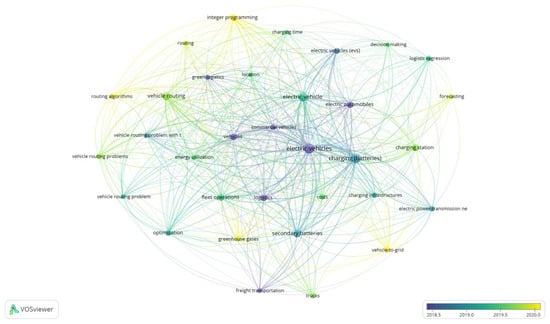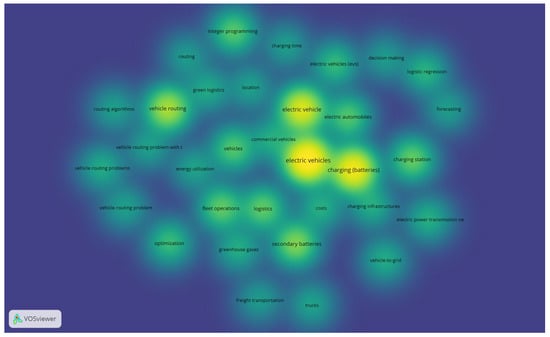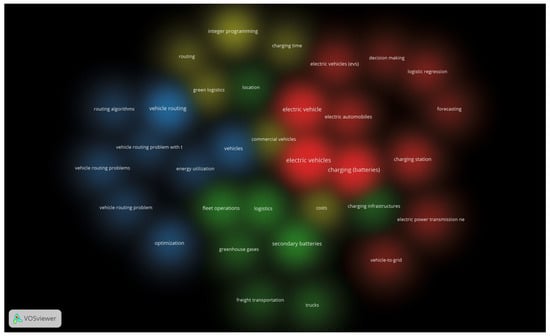1. Introduction
With the unprecedented rise of electromobility, the logistics landscape is undergoing transformative changes
[1][2][1,2], reflecting the shifting paradigms in both the transport
[3] and energy sectors
[4][5][4,5]. While much discourse on electromobility emphasizes environmental issues, labor market dynamics
[6], and social concerns, economic implications often receive less attention
[3][7][3,7]. Th
is article
endeavors to fill that gap by focusing on the logistics and economic intricacies embedded within the concept of the ‘business ecosystem’
[8][8]. This ecosystem, defined by mutual value creation and strategic collaboration along with infrastructure and logistics, has the potential to drive economic growth and create new green jobs in the energy
[9] and transport sectors
[10].
As the integration of electric vehicles and related infrastructure
[11][12][11,12] becomes increasingly widespread
[13][14][13,14], understanding the evolution of logistics within this context becomes paramount
[15][16][15,16]. The energy and transport sectors are essential elements of every country’s economy
[15][17][15,17]. Therefore, the focus on the logistics of electromobility represents broader systemic shifts
[18][19][18,19] in how businesses operate
[20][21][20,21], interact
[17][22][23][17,22,23], and innovate within these sectors
[20][24][25][20,24,25].
Electromobility poses new challenges for the energy sector
[26][27][26,27], especially as the sector grapples with the intricacies of implementing automation
[13][28][13,28] through the Internet of Things (IoT), minimizing operational costs
[29][30][29,30], and maximizing the utilization of electric vehicles
[31][32][31,32]. On the other hand, electromobility also introduces new challenges to the power grid charging power demand changes
[33][34][33,34], which vary during the day and vehicle types energy consumption
[35][36][35,36]. An in-depth look at the European Union context uncovers complexities such as varied power standards
[35][37][38][35,37,38], location-specific emissions
[39][40][39,40], and the meticulous task of route planning based on available infrastructure and workforce
[10][41][10,41]. Additionally, with the emergence of technologies like Artificial Intelligence (AI), there is a notable emphasis on process automation, including the vital aspects of planning
[11][42][11,42], strategy, and decision-making
[34][43][44][34,43,44]. This evolving landscape provides businesses with the opportunity to focus on the systematic interconnections between individual components, fostering a more unified and integrated approach
[45][46][47][45,46,47]. It can also point the way toward technology development and improvement for the whole economy
[14][47][48][14,47,48]. In this complex landscape of electromobility, two perspectives are gaining popularity in both business practice and theory
[4][12][4,12]: logistics and the business ecosystem
[6][28][6,28]. Those two views help to understand the connections between the transportation and energy sectors
[49][50][49,50].
Significant and dominant trends can be observed in the global economy
[51][76], influencing not only the present but also the future of the transport and energy sectors
[41][52][41,77]. Changes in the energy sector drive development
[28][53][28,78] and shifts in other parts of the economy
[54][55][79,80], as there is a business ecosystem operating across various economic sectors
[56][57][70,81]. With increasing globalization, these trends are becoming similar and even unified across the developed world
[58][59][82,83]. Development trends observed on a global scale are called megatrends
[60][61][84,85]. Highly developed countries are at the forefront of the introduction of modern solutions, while developing countries tend to rely on their implementation
[62][63][86,87]. An example of this phenomenon can be seen in the charging station networks in the European Union, and their development is at the core of the electromobility trend highlighted and the trends accompanying logistics
[53][64][78,88]. Notable is the logistics trend radar proposed by the company DHL
[60][84]. The trend radar (
Figure 1) is a graphical analysis of various trends that illustrates the links between logistics processes and social aspects.
Figure 1. Logistics Trend Radar version 6.0 by DHL (Copyright Creative Commons Attribution (CC BY). Source: Authors’ elaboration based on
[60][84].
The megatrends in logistics are illustrated in
Figure 1, focusing on the future of logistics. While the radar was developed based on current events and business environment observations,
Figure 1 offers two trend perspectives. These are categorized within the radar into two distinct areas: the near future, up to 5 years (represented by the internal part of the circle in light yellow), and the further future, between 5 and 10 years (depicted in dark yellow). Additionally, the overview is bifurcated into two primary directions: the first, highlighted in green, denotes social and business trends, while the second, highlighted in blue, underscores technology trends
[27][65][27,89].
Figure 1 also shows the hierarchy of trends based on their impact. At the bottom of
Figure 1, low-impact trends are indicated, and with their higher position on the radar, they are more relevant, and at the top, they have a high impact on shaping the reality of the logistics sector
[66][90]. While the radar indicates logistics trends, areas such as alternative energy solutions, big data analytics
[67][68][91,92], decarbonization, and interactive AI have connections with the energy and transportation sectors
[69][93]. Together, they form a business ecosystem perspective
[70][71][94,95].
2. Logistics and Business Ecosystem of Electromobility
The academic community has extensively explored the technological intricacies of electromobility within the logistics sector. Optimization challenges stemming from advanced programming and automation, paired with recharging considerations, underscore the crucial interplay between technology and infrastructure in leveraging the full potential of electromobility in logistics.
New mobility models introduce market elements lacking standardization. Bibliometric map analyses reveal links between logistics and electromobility, yet they feature a wide range of terminology. This variability accentuates the importance of an all-encompassing interdisciplinary understanding. The term “electromobility”, often abbreviated as “e-mobility”, spans a vast range, encompassing electric vehicles, charging stations, and nascent systems like integrated charging networks. This broad perspective is reinforced by the array of keywords detected in the literature under review. An interesting observation is that slight terminological differences in Scopus database queries can lead to vast differences in article yields.
Research predominantly emphasizes transportation, fleet management, and the conceptualization of a cohesive charging station network. These domains illuminate the growing relevance of electromobility in logistics and the broader business arena. As a burgeoning segment within transportation, e-mobility paves the way for innovative systems. Endeavors focusing on electric vehicles gain momentum from synergies with artificial intelligence advancements, addressing challenges from charging station networks to enhancing autonomous driving capabilities.
The evolution of electromobility is defined by its cross-sectoral interactions. Beyond mere technological intersections, cooperative ventures span domains from electricity provision to AI-orchestrated transport solutions. These collaborative endeavors, situated at the confluence of technological progression and emergent market demands, highlight electromobility’s transformative trajectory. They not only mark an industry’s advancement but also signify a paradigm shift in conceptualizing and operationalizing transportation and logistics in today’s interconnected age.
In summary, the literature on electromobility in logistics is both exhaustive and dynamic. While identifiable patterns emerge, the area remains in flux, shaped by technological innovations, market shifts, and interdisciplinary discussions. As electromobility progresses, continuous scholarly engagement is essential to ensure comprehensive and up-to-date understanding.
Topics include the role of advanced programming in optimization, the indispensable nature of infrastructure, and the plethora of terminologies within the electromobility sphere. The
current literature is enhanced by these insights, further enriched by illustrative diagrams and tables. A detailed visualization underscores the symbiosis between technology and infrastructure in logistics, a critical factor in amplifying the benefits of electromobility (
Figure 1). An in-depth analysis of the relationship between emerging mobility models and non-standardized market elements stresses the need for holistic interdisciplinary insight (
Figure 2). Using the Scopus database, the study highlights variations in article outputs based on subtle terminology differences. A thorough examination of trends, such as fleet management and charging station networks, provides a comprehensive view of the rapidly evolving electromobility landscape within logistics (
Figure 3). This inquiry also reveals that integrating electromobility with AI advancements opens doors
[72][180] to numerous innovative opportunities (
Figure 4). The domain’s multiple intersections, ranging from electricity provision to AI-augmented transport solutions, emphasize the sector’s transformative potential (
Figure 5). Ultimately, a conceptual model is presented, underscoring electromobility’s significance in the broader context of global energy transitions and sustainable mobility (
Figure 6).
Figure 2.
Ratio of cited to un-cited publications. Source: Authors’ elaboration.
Figure 3. Indexed keywords co-occurrence map;. Results of Q1 analyzed with full counting method. Source: Authors’ elaboration in VOSviewer (version 1.6.19).
Figure 4.
Overlay map of indexed co-occurrences. Source: Authors’ elaboration in VOSviewer (version 1.6.19).
Figure 5.
Density visualisation map. Source: Authors’ elaboration in VOSviewer (version 1.6.19).
Figure 6.
Cluster density visualization map. Source: Authors’ elaboration in VOSviewer (version 1.6.19).
The convergence of energy and transportation domains, spurred by electromobility’s ascent, is inducing transformative changes in logistics. These transitions capture not only broad systemic evolutions but also spotlight the intertwined dynamics of energy storage, distribution, and transportation.
Key challenges arising from electromobility’s burgeoning role in logistics include the integration of IoT-driven automation, operational cost-effectiveness, and strategies to bolster EV utilization
[73][181]. Within the European Union, these challenges are further nuanced by varied power standards, regional emission goals, and the delicate craft of route design, dependent on charging infrastructure. The accelerated adoption of advanced technologies, notably artificial intelligence (AI), is forging pathways for enhanced automation, notably impacting strategic planning and decision-making.
Electromobility represents a harbinger of change, reshaping the logistics and energy landscapes alike. This investigation highlights seminal contributions to the dialogue, focusing on primary obstacles and considerations. The deep-seated interconnections between electromobility, energy, and logistics emphasize the urgency of a coordinated research and deployment strategy. As technological and infrastructural advancements surge forward, future research is encouraged to build on these foundational insights, directing efforts towards sustainable solutions in logistics. By scrutinizing the business milieu surrounding electromobility, the study underscores adaptability’s quintessence. Such adaptability extends beyond mere technological progression, intertwining with existing societal, legal, and environmental contexts. The triumph of electromobility is not predicated solely on technological milestones but thrives in a dynamic business environment characterized by adaptability, mutual innovation, and cohesive partnerships. This interdisciplinary approach is very necessary to investigate electromobility, and observing logistics and business ecosystems adds real value to the existing body of knowledge in this domain. Through a sustainability prism, this underscores the alignment of the ecosystem with shared objectives, mutual benefit realization, and its intricate interplay with myriad stakeholders.






